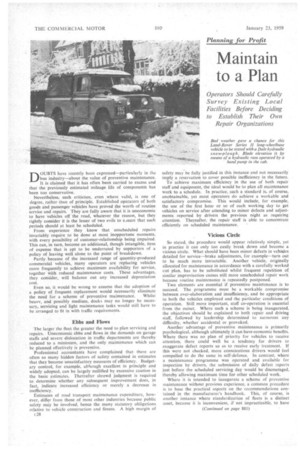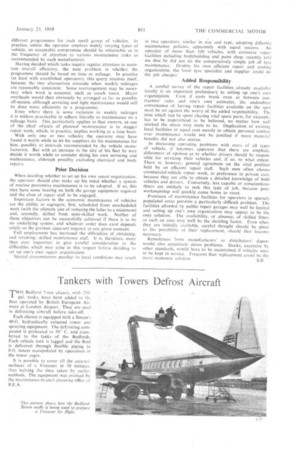Maintain to a Plan
Page 64

Page 67

If you've noticed an error in this article please click here to report it so we can fix it.
Operators Should Carefully Survey Existing Local Facilities Before Deciding to Establish Their Own Repair Organizations
DOUBTS have recently been expressed—particularly in the bus industry—about the value of preventive maintenance. It is claimed that it has often been carried to excess and that the previously estimated mileage life of components has
been too conservative.
Nevertheless, such criticism, even .where valid, is one of degree, rather than of principle. Established operators of both goods and passenger vehicles have proved the worth of routine service and repairs. They are fully aware that it is uneconomic to have vehicles off the road, whatever the reason, but they rightly consider it is the lesser of two evils to easure that such periods should at least be scheduled.
From experience they know that unscheduled repairs invariably require to be done at most inopportune moments, with every possibility of customer-relationship being impaired. This can, in turn, become an additional, though intangible, item of expense that is apt to be underrated by supporters of a policy of leaving well alone to the point of breakdown.
Partly because of the increased range of quantity-produced commercial vehicles, many operators are replacing vehicles more frequently to achieve maximum availability for service, together with reduced maintenance costs. These advantages, they consider, will balance out any increased depreciation cost.
Even so, it would be wrong to assume that the adoption of a policy of frequent replacement would necessarily eliminate the need for a scheme of preventive maintenance. Whilst heavy, and possibly medium, docks may no longer be necessary, servicing and light maintenance tasks would still have to be arranged to fit in with traffic requirements.
Ebbs and Flows
The larger the fleet the greater the need to plan servicing and repairs. Uneconomic ebbs and flows in the demands on garage staffs and severe dislocation in traffic departments are thereby reduced to a minimum, and the only maintenance which can be planned effectively is preventive.
Professional accountants have complained that there are often so many hidden factors of safety contained in estimates that they become unsatisfactory measures of efficiency. Budgetary control, for example, although excellent in principle and widely adopted, can be largely nullified by excessive caution in the basic estimates. Thereafter shrewd judgment is required to determine whether any subsequent improvement does, in fact, indicate increased efficiency or merely a decrease in inefficiency.
Estimates of road transport maintenance expenditure, however, differ from those of most other industries because public safety may be involved, hence the many statutory obligations relative to vehicle construction and fitness. A high margin of c28 safety may be fully justified in this instance and not necessarily imply a reservation to cover possible inefficiency in the future.
To achieve maximum efficiency in the use of both repair staff and equipment, the ideal would be to plan all maintenance work to a schedule. In practice; such a standard is, of course, unobtainable, yet most operators do achieve a workable and satisfactory compromise. This would include, for example, the use of the first hour or so of each working day to get vehicles on service after attending to minor defects and adjustments reported by drivers the previous night as requiring attention. Thereafter, the repair staff is able to concentrate efficiently on scheduled maintenance.
Vicious Circle
So stated, the procedure would appear relatively simple, yet in practice it can only too easily break down and become a vicious circle, What should have been minor defects in vehiviles detailed for service—brake adjustments, for example—turn out to be much more intractable. Another vehicle, originally allocated for maintenance in accordance with a carefully worked out plan, has to be substituted whilst frequent repetition of similar improvisation causes still more unscheduled repair work because routine maintenance is repeatedly postponed.
Two elements are essential if preventive maintenance is to succeed. The programme must be a workable compromise between over-elaboration and insufficiency, and be appropriate to both the vehicles employed and the particular conditions of operation. Still more important, staff co-operation is essential from the outset. Where such a scheme is being inaugurated, the objectives should be explained to both repair and driving staff, followed by leadership determined to surmount any difficulty, whether accidental or provoked.
Another advantage of preventive maintenance is primarily psychological, although ultimately it can have economic benefits. Where there was no plan of priority for vehicles to receive attention, there could well be a tendency for drivers to exaggerate defect reports so as to receive early treatment. If this were not checked, more conscientious drivers would feel compelled to do the same in self-defence. In contrast, where a maintenance programme was operated and available for inspection by drivers, the submission of daily defect reports just before the scheduled servicing day would be discouraged, thereby allowing maximum time for other scheduled work.
Where it is intended to inaugurate a scheme of preventive maintenance without previous experience, a common procedure is to base the practical aspects on the recommendations contained in the manufacturer's handbook. This, of course, is another instance where standardization of fleets is a distinct asset, because it is inconvenient, if not impracticable, to have
different programmes for each small group of vehicles. In practice, unless the operator employs widely varying types of vehicle, an acceptable compromise should be obtainable as to the frequency of attention to various maintenance tasks as ream-intended by each manufacturer.
Having decided which tasks require regular attention to maintain overall efficiency, the next problem is whether the , programme should be based on time or mileage. In practice (at least with established operators), this query resolves itself, because the two alternatives coincide •when weekly mileages are reasonably consistent. Some rearrangement may be necessary when work is seasonal, such as coach tours. Major overhaul§ would then obviously be arranged as far as possible off-season, although servicing and light maintenance would still be done more efficiently to a programme.
Even where there is some variation in weekly mileages it is seldom practicable to adhere literally to maintenance on a mileage basis. This particularly applies to fleet owners, as one of the chief objects of planned maintenance is to stagger repair work, which, in practice, implies working to a time basis.
With only 041e or two vehicles the operator may have found it worth while to let his suppliers do his maintenance for him, possibly at intervals recommended by the vehicle manufacturers. But with an increase in the size of his fleet he may decide it worth while to consider doing his own servicing and maintenance, although possibly excluding electrical and body repairs.
Prior Decision
When deciding whether to set up his own repair organization. the operator should also make up his mind whether a system of routine preventive maintenance is to be adopted. If so, this may have some bearing on both the garage equipment required and the class of repair staff to be engaged.
Important factors in the economic maintenance of vehicles are the ability to segregate, first, scheduled from unscheduled work (with the ultimate aim of reducing the latter to a minimum) and, secondly, skilled from semi-skilled work. Neither of these objectives can be successfully achieved if there is to he no underlying system, and whatever order does exist depends solely on the greatest apparent urgency at any given moment.
Full employment has increased the difficulties of obtaining, and retaining, skilled maintenance staff. It is, therefore, more than ever important to give careful consideration to the difficulties which may arise in this respect before deciding to set up one's own repair organization.
Special circumstances peculiar to local conditions may result in two operators, similar in size and type, adopting differing maintenance policies, apparently with equal success. An operator of more than 100 vehicles, with extensive repair facilities including bodybuilding and paint shop, recently told me that he did not do the comparatively simple job of tyre maintenance. Despite his own efficient repair and costine organization, the local tyre specialist and supplier could do the job cheaper.
Added Responsibility A careful survey of the repair facilities, already available locally is an important preliminary to setting up one's own organiiation. Even if costs break even as between contractors' rates and one's own estimates, the undoubted convenience of having repair facilities available on the spot must be set against the worry of the added responsibility: The time which can be spent chasing vital spare parts, for example, has to be .experienced to be believed, no matter how well stocked the stores may seem to be. Duplication of existing lOcal facilities at equal cost merely to obtain personal control over maintenance would not be justified if more material benefits did not also accrue.
In discussing operating probleins with users' of all types of vehicle, it becomes apparent that there are emphatic differences of opinion as to whether drivers should be responsible for servicing their vehicles and, if so, to what extent. There is, however, general agreement on the vital position held by an efficient repair staff. Such men often choose commercial-vehicle repair work, in preference to private cars. because they are able to obtain a detailed knowledge of both vehicles and drivers. Conversely, less capable or conscientious fitters are unlikely to seek this type of job, because poor workmanship will quickly come home to roost.
Provision of maintenance facilities for operators in sparsely populated areas presents a particularly difficult problem. The facilities afforded by public repair garages may well be limited and setting up one's own organization may appear to be the only solution. The availability, or absence,of skilled litters in such an area may well be the deciding factor. Even when they are initially available, careful thought should be given to the possibility of their replacement, should that become necessary.
Remoteness from manufacturers or distributors" depots would also accentuate stores problems. Stocks, excessiYe 11), other standards, would have to be maintained if vehicles were to be kept in service. Frequent fleet replacement could he the
more economic solution. S.B.




































































































































































































